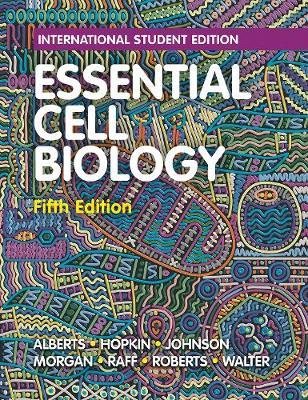
- Essential Cell Biology
- Bruce Alberts, Dennis Bray, Karen Hopkin, Alexander Johnson, Julian Lewis, Martin Raff, Keith Roberts, Peter Walter
- Garland Science, Taylor & Francis Group
| COURSE | CHEM046 - ESSENTIAL CELL BIOLOGY |
| TYPE OF COURSE | Core, Mandatory |
| YEAR | Year 1, Semester B, undergraduate Chemistry students |
| SEMESTER | Spring |
| CREDITS | 3 (ECTS=4) |
| DEPARTMENT | Chemistry, University of Crete |
| LECTURES | Chemistry Auditorium A1, Monday 12.00-14.00, Friday 11.00-13.00 |
| COURSE MATERIAL | In Google Classroom (class code: ) you can have access to i. textbooks of the course, ii. Powerpoint presentations of the lectures, iii. pdf files of the lecture presentations, iv. previous exams questions & answers, v. Video files of ZOOM lectures, vi. educational videos. |

Download: INFO pptx (INFO pdf)
- Introduction to cells
- Microscopy
- Cell architecture
- Life's common mechanisms
-
The molecular design of life
- Biochemical unity underlies Biological diversity
- DNA illustrates the interplay between form and function
- Chemical components of cells
- What are macromolecules
- Chemical bonds and groups
- An outline of some of the types of sugar
- Fatty acids and other lipids
- The 20 amino acids found in proteins
- A survey of the nucleotides
- The principal types of weak noncovalent bonds
- Energy, Catalysis and Biosynthesis
- The use of energy by cells
- Free energy and Catalysis
DNA and Chromosomes
- The Structure of DNA
- A DNA Molecule Consists of Two Complementary Chains of Nucleotides
- The Structure of DNA Provides a Mechanism for Heredity
- The Structure of Eukaryotic Chromosomes
- Eukaryotic DNA Is Packaged into Multiple Chromosomes
- Chromosomes Contain Long Strings of Genes
- Specialized DNA Sequences Are Required for DNA Replication and Chromosome Segregation
- Interphase Chromosomes Are Not Randomly Distributed Within the Nucleus
- The DNA in Chromosomes Is Always Highly Condensed
- Nucleosomes Are the Basic Units of Eukaryotic Chromosome Structure
- Chromosome Packing Occurs on Multiple Levels
- The Regulation of Chromosome Structure
- Changes in Nucleosome Structure Allow Access to DNA
- Interphase Chromosomes Contain Both Condensed and More Extended Forms of Chromatin
DNA Replication, Repair, and Recombination
DNA REPLICATION
- Base-Pairing Enables DNA Replication
- DNA Synthesis Begins at Replication Origins
- New DNA Synthesis Occurs at Replication Forks
- The Replication Fork Is Asymmetrical
- DNA Polymerase Is Self-correcting
- Short Lengths of RNA Act as Primers for DNA Synthesis
- Proteins at a Replication Fork Cooperate to Form a Replication Machine
- Telomerase Replicates the Ends of Eucaryotic Chromosomes
DNA REPAIR
- Mutations Can Have Severe Consequences for a Cell or Organism
- A DNA Mismatch Repair System Removes Replication Errors That Escape the Replication Machine
- DNA Is Continually Suffering Damage in Cells
- The Stability of Genes Depends on DNA Repair
- Double-Strand Breaks Can be Repaired Rapidly But Imperfectly
- A Record of the Fidelity of DNA Replication and Repair Is Preserved in Genome Sequences
HOMOLOGOUS RECOMBINATION
Homologous Recombination Requires Extensive Regions of Sequence SimilarityHomologous Recombination Can Flawlessly Repair DNA Double-strand BreaksHomologous Recombination Exchanges Genetic Information During Meiosis
MOBILE GENETIC ELEMENTS AND VIRUSES
- Mobile Genetic Elements Encode the Components They Need for Movement
- The Human Genome Contains Two Major Families of Transposable Sequences
- Viruses Are Fully Mobile Genetic Elements That Can Escape from Cells
- Retroviruses Reverse the Normal Flow of Genetic Information
From DNA to Protein: How Cells Read the Genome
FROM DNA TO RNA
- Portions of DNA Sequence Are Transcribed into RNA
- Transcription Produces RNA Complementary to One Strand of DNA
- Several Types of RNA Are Produced in Cells
- Signals in DNA Tell RNA Polymerase Where to Start and Finish- Initiation of Eucaryotic Gene Transcription Is a Complex Process
- Eucaryotic RNA Polymerase Requires General Transcription Factors
- Eucaryotic RNAs Are Transcribed and Processed Simultaneously in the Nucleus
- Eucaryotic Genes Are Interrupted by Noncoding Sequences
- Introns Are Removed by RNA Splicing
- Mature Eucaryotic mRNAs Are Selectively Exported from the Nucleus
- mRNA Molecules Are Eventually Degraded by the Cell
- The Earliest Cells May Have Had Introns in Their Genes
FROM RNA TO PROTEIN
- An mRNA Sequence Is Decoded in Sets of Three Nucleotides
- tRNA Molecules Match Amino Acids to Codons in mRNA
- Specific Enzymes Couple tRNAs to the Correct Amino Acid
- The RNA Message Is Decoded on Ribosomes
- The Ribosome Is a Ribozyme
- Codons in mRNA Signal Where to Start and to Stop Protein Synthesis
- Proteins Are Made on Polyribosomes